The Ready to Drink Shakes Market is estimated to be valued at USD 13.7 billion in 2025 and is projected to reach USD 28.2 billion by 2035, registering a compound annual growth rate (CAGR) of 7.5% over the forecast period.
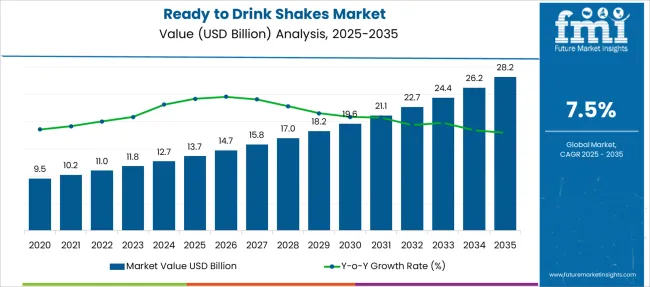
| Metric | Value |
|---|---|
| Ready to Drink Shakes Market Estimated Value in (2025 E) | USD 13.7 billion |
| Ready to Drink Shakes Market Forecast Value in (2035 F) | USD 28.2 billion |
| Forecast CAGR (2025 to 2035) | 7.5% |
The ready to drink shakes market is expanding steadily due to increasing consumer demand for convenient nutrition and on-the-go beverage options. Changes in lifestyle patterns have led to higher consumption of packaged shakes that offer balanced nutrition and satisfy hunger quickly.
The market has seen continuous product innovations focusing on taste, health benefits, and clean labeling, appealing to health-conscious consumers. Packaging developments, especially in bottles, have enhanced product portability and shelf life, further boosting adoption.
Consumer preferences have also shifted towards indulgent yet nutritious flavors, with chocolate being particularly popular. Retail expansion and online sales growth have improved product accessibility. Looking forward, the market is expected to grow as manufacturers introduce fortified and functional shake options targeting diverse consumer needs. Growth is forecasted to be driven by the Conventional nature segment, Bottles as the preferred packaging type, and Chocolate as the leading flavor.
The market is segmented by Nature, Packaging Type, and Flavor and region. By Nature, the market is divided into Conventional and Organic. In terms of Packaging Type, the market is classified into Bottles, Tetra packs/Carton, and Cans. Based on Flavor, the market is segmented into Chocolate, Banana, Strawberry, Vanilla, Citrus, Berries, and Others. Regionally, the market is classified into North America, Latin America, Western Europe, Eastern Europe, Balkan & Baltic Countries, Russia & Belarus, Central Asia, East Asia, South Asia & Pacific, and the Middle East & Africa.
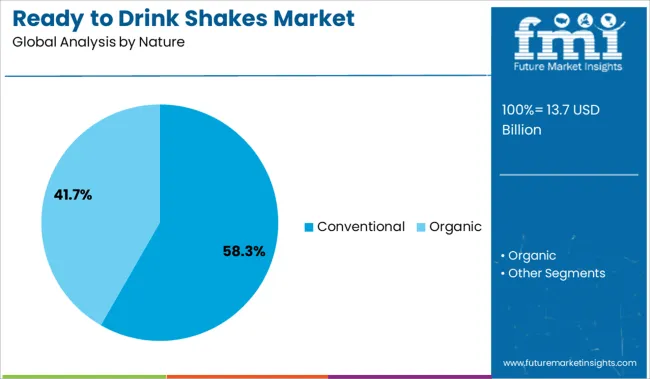
The Conventional segment is anticipated to account for 58.3% of the ready to drink shakes market revenue in 2025, maintaining its dominance among product types. This segment has grown due to widespread consumer trust in traditional formulations that provide familiar taste profiles and consistent nutritional value.
Conventional shakes have been preferred for their proven efficacy in providing energy and essential nutrients without the perceived complexity of newer functional ingredients. Consumers who seek reliable and affordable nutrition options continue to support this segment.
Furthermore, distribution channels have prioritized conventional shakes because of their broad appeal and easier regulatory compliance compared to specialized formulations. The balance of taste, nutrition, and price has made the Conventional segment the backbone of the ready to drink shakes market.
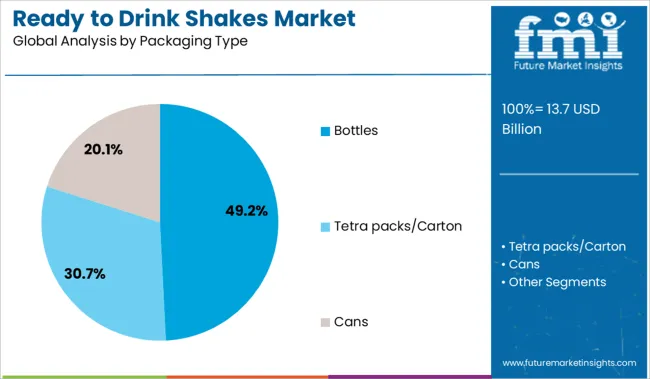
The Bottles packaging segment is projected to contribute 49.2% of the market revenue in 2025, establishing itself as the dominant packaging format. Bottled shakes have been favored due to their convenience, resealability, and ability to maintain product freshness.
The portability offered by bottles suits busy consumers looking for quick nutrition on the go. Advances in lightweight and recyclable bottle materials have enhanced environmental appeal while meeting safety standards.
Retailers have increased shelf space for bottled beverages to cater to evolving consumer shopping habits. Promotional activities and product visibility in refrigerated sections have further supported the bottled shake segment. As convenience remains a priority for consumers, bottles are expected to remain the preferred packaging choice.
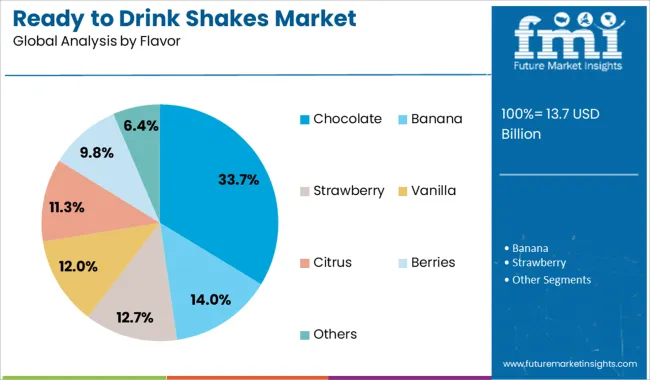
The Chocolate flavor segment is expected to hold 33.7% of the ready to drink shakes market revenue in 2025, positioning it as the most popular flavor. Chocolate has been favored for its rich taste and widespread consumer acceptance across age groups.
Flavor innovation within chocolate varieties has allowed brands to maintain consumer interest while offering indulgence alongside nutrition. The comforting and familiar profile of chocolate shakes has led to repeated purchases and brand loyalty.
Additionally, marketing campaigns have often highlighted chocolate flavor as a premium choice balancing taste and health. Seasonal and limited-edition chocolate variants have further enhanced consumer excitement. Given its strong emotional and sensory appeal, the Chocolate flavor segment is anticipated to sustain its market leadership.
| Market Statistics | Details |
|---|---|
| H1,2024 (A) | 7.4% |
| H1,2025 Projected (P) | 7.5% |
| H1,2025 Outlook (O) | 8.3% |
| BPS Change : H1,2025 (O) - H1,2025 (P) | (+) 75 ↑ |
| BPS Change : H1,2025 (O) - H1,2024 (A) | (+) 82.5 ↑ |
In the first half of 2024, the global market for Ready to Drink Shake Market grew by 7.4 percent. Though not equally distributed throughout all regions, this growth is stronger in developing markets, where it reached 7.5%. Thus, during H1 2025, there will be a 82.5 BPS point difference between predicted and projected growth.
There have been recent developments in the ready-to-drink shake market, with new products being released by major players such as Coca-Cola and PepsiCo. These shakes are designed to be convenient and easy to use, with no need for preparation or cleanup.
They are available in a variety of flavors, including chocolate, vanilla, strawberry, and banana. Some of the brands that offer these shakes include Odwalla, Naked, Muscle Milk, and Boost.
In a move to cash in on the popularity of ready-to-drink shakes, supplement company ViSalus has announced the launch of its own line of RTD shakes. The shakes, which are set to hit stores in late July, will come in four flavors: chocolate, vanilla, strawberry, and mango.
The company is hoping that the new product will help it capitalize on the growing popularity of ready-to-drink shakes. ViSalus is no stranger to the shake market; it already sells a line of powdered shake mixes. But the company is hoping that the new RTD shakes will be more popular with consumers.
There's a new beverage trend on the rise, and it's all about ready-to-drink shakes. These shakes are perfect for people who are short on time or don't want to bother with making a smoothie themselves. They're also great for on-the-go snacking, as they're portable and easy to drink.
Some of the best things about ready-to-drink shakes is that they come in a variety of flavors and can be tailored to fit any dietary needs. Whether you're looking for a shake that's low in calories or one that's high in protein, you'll be able to find something that fits your needs. And, since there are so many different brands and flavors available, you can find the perfect shake for your taste buds.
Ready to Drink Shakes sales grew at a CAGR of 6.9% between 2020 and 2025. The period marked the entry of various market players and product innovations.
Consumers are switching to quick and nutritious food options due to their fast-paced and hectic lifestyles. As a result of this scenario, RTD shakes that provide nutrient-based beverages and encourage active lives have gained traction. These beverages can be substituted for the meal to shorten the time spent eating. RTD shakes are preferred by roughly 22% of consumers in the United States to cut down on meals.
Increasingly using e-commerce platforms for transactions and shopping by consumers, the market for ready-to-drink shakes is expected to grow in both developed and developing economies. The growth of the IT industry has resulted in the development of a slew of new and simple ways to transact and shop across a wide range of industries.
Increased usage of e-commerce platforms is also driving the food and beverage industry, as customers place a premium on expediency and ease of conducting business.
Similarly, potential customers of ready-to-drink shakes have been entranced by e-commerce platforms due to the ease and improved availability of the products, even in rural places. Sales of ready-to-drink shakes on e-commerce platforms are expected to increase over the projection year.
Furthermore, Due to their growing popularity, a growing number of health fitness centres are promoting the drinking of RTD shakes. There are many different types of ready-to-drink protein shakes on the market, including rice, whey, soy, casein, pea, and hemp, that are used for muscle building, weight loss, and other purposes.
Another factor driving market expansion is a growing consumer preference for vegan products, which has boosted demand for plant-based RTD shakes. Plant-based RTD shakes made with pea, hemp, and pumpkin seed are being introduced by companies. To meet consumer demand, Vega (USA) created a protein nutrition smoothie.
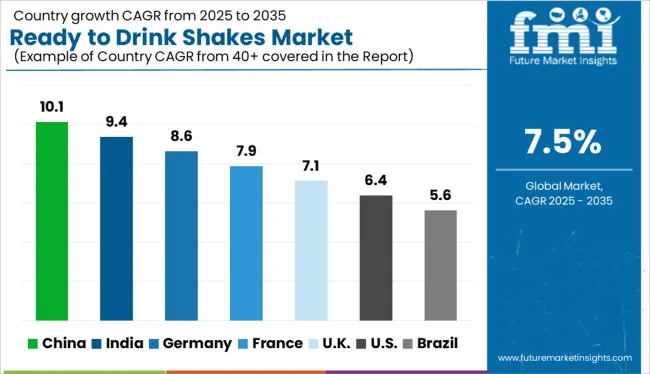
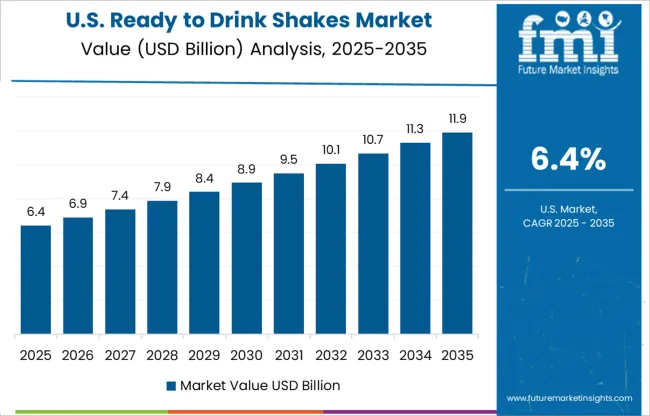
During the forecast period of 2025 to 2035, the ready-to-drink shake market in USA is predicted to grow significantly. Individuals in the country are increasingly spending money on their health, which could be a significant development element. Rising disposable income could boost growth chances even more.
Obesity is a major problem in the United Kingdom. Ready-to-drink shakes are used as a meal substitute to help people lose weight by limiting calorie intake. Further, The ready-to-drink shakes market is predicted to develop at a positive rate over the forecast period, owing to rising disease prevalence and, as a result, a rising trend of health and wellbeing in the region.
Despite the fact that ready-to-drink shakes offer fantastic results for gym goers and fitness fanatics, the product is still in its infancy in developing countries like China, which are in a period of transformation. As a result of the luxury character of the product and its high price, market penetration in emerging countries may be limited.
Chocolate is the most popular flavour in the global market for ready-to-drink shakes, followed by vanilla and other tastes. Exotic flavours like vanilla and fruits are making a comeback, and vanilla-flavored ready-to-drink shakes are expected to rise at a fast rate over the next few years.
Bottles are expected to capture a significant share of the overall market, depending on the packaging style. The reusability of PET and glass bottles is well recognized. Furthermore, enterprises in the field are recycling plastic bottles in order to receive tax benefits from the government for their environmentally favourable features.
Furthermore, recycled bottles reduce packing costs, resulting in higher earnings for the company. In the United States, Huel, for example, introduced chocolate RTD in 100 percent recyclable bottles produced from 25 percent recycled plastic in 2020.
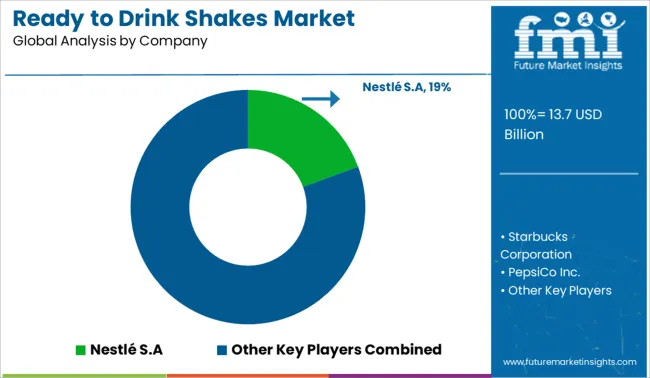
Some of the key players operating in the Ready to Drink Shake market are Nestlé S.A, Starbucks Corporation, PepsiCo Inc., Monster beverage Co., Lotte Chilsung Beverage Co., The Coca-Cola Company, The J.M Smucker Company, Bolthouse Farms, Inc., Arla Foods amba, Atkin Nutritionals Inc. and others.
| Attribute | Details |
|---|---|
| Forecast Period | 2025 to 2035 |
| Historical Data Available for | 2020 to 2024 |
| Market Analysis | USD Billion for Value and Metric Ton for Volume |
| Key Regions Covered | North America; Latin America; Europe; East Asia; South Asia; Oceania; and Middle East & Africa |
| Key Countries Covered | United States, Canada, Brazil, Mexico, Germany, UK, France, Italy, Spain, Nordic, Russia, Poland, China, Japan, South Korea, India, Thailand, Indonesia, Malaysia, Singapore, Australia, New Zealand, GCC countries, North Africa, South Africa, others. |
| Key Segments Covered | Nature, Packaging, Flavor and Region |
| Key Companies Profiled | Nestlé S.A; Starbucks Corporation; PepsiCo Inc.; Monster beverage Co.; Lotte Chilsung Beverage Co.; The Coca-Cola Company; The J.M Smucker Company; Bolthouse Farms Inc.; Arla Foods; Amba; Atkin Nutritionals Inc.; Nutrineo; CytoSport, Inc.; Nature’s Best; Orgain, Inc; Soylent; Others (on additional request) |
| Report Coverage | Market Forecast, Company Share Analysis, Competition Intelligence, DROT Analysis, Market Dynamics and Challenges, and Strategic Growth Initiatives |
| Customization & Pricing | Available upon Request |
The global ready to drink shakes market is estimated to be valued at USD 13.7 billion in 2025.
The market size for the ready to drink shakes market is projected to reach USD 28.2 billion by 2035.
The ready to drink shakes market is expected to grow at a 7.5% CAGR between 2025 and 2035.
The key product types in ready to drink shakes market are conventional and organic.
In terms of packaging type, bottles segment to command 49.2% share in the ready to drink shakes market in 2025.






Full Research Suite comprises of:
Market outlook & trends analysis
Interviews & case studies
Strategic recommendations
Vendor profiles & capabilities analysis
5-year forecasts
8 regions and 60+ country-level data splits
Market segment data splits
12 months of continuous data updates
DELIVERED AS:
PDF EXCEL ONLINE
Ready Mix Joint Compound Market Size and Share Forecast Outlook 2025 to 2035
Ready Meals Packaging Market Size and Share Forecast Outlook 2025 to 2035
Ready-made Food Bases Market Analysis - Size, Share, and Forecast 2025 to 2035
Ready-mix Concrete Market Trends & Outlook 2025 to 2035
Competitive Overview of Ready Meals Packaging Market Share
Ready-to-eat Canned Tuna Market Size and Share Forecast Outlook 2025 to 2035
Ready to Use Intermittent Catheters Market Size and Share Forecast Outlook 2025 to 2035
Ready-to-Eat Food Packaging Market Size and Share Forecast Outlook 2025 to 2035
Ready To Eat Seafood Snacks Market Size and Share Forecast Outlook 2025 to 2035
Ready-to-Finish Bakery Products Market Analysis - Size, Share and Forecast 2025 to 2035
Ready-to-eat Food Market Analysis - Size, Share, and Forecast Outlook 2025 to 2035
Ready-to-Use Therapeutic Food Market Trends and Forecast 2025 to 2035
Ready-to-Serve Cocktails Market Trends - Innovation & Demand 2025 to 2035
Ready-to-eat Cups Market Analysis by Product Type, Nature, Packaging, Distribution Channel, and Region - Growth, Trends, and Forecast through 2035
Ready-To-Use Supplementary Food Market Analysis Hospital & Clinics, Charities, NGOs, And Others Through 2035
Ready to Drink (RTD) Packaging Market Size and Share Forecast Outlook 2025 to 2035
Ready to Drink Coffee Market Analysis - Size, Share, and Forecast Outlook 2025 to 2035
Ready-to-Drink Beauty Beverage Market Analysis by Ingredients, Flavor, Form and Distribution Channel Through 2035
Ready To Drink (RTD) Tea Market Trends - Functional & Refreshing Beverage Growth 2025 to 2035
Ready To Drink Cocktails Market Growth – Size, Trends & Forecast 2025-2035

Thank you!
You will receive an email from our Business Development Manager. Please be sure to check your SPAM/JUNK folder too.
Chat With
MaRIA